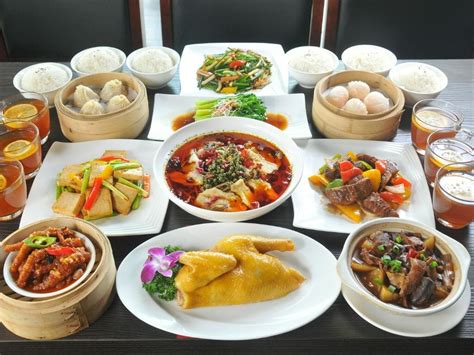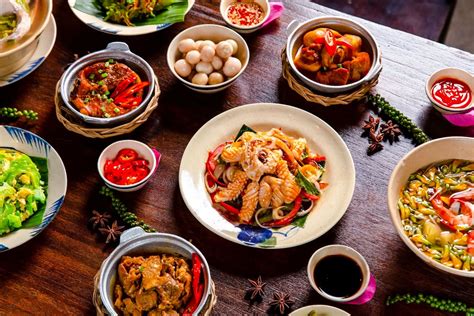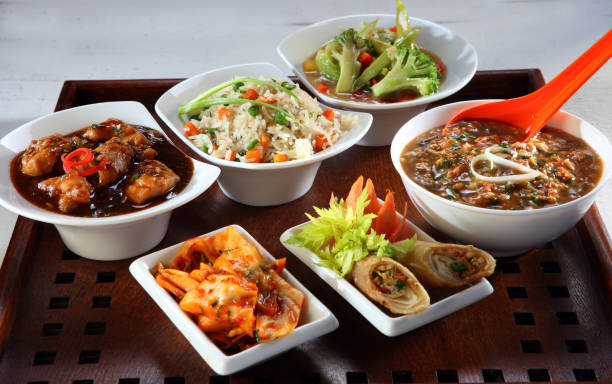Chinese cuisine is a world of rich, diverse flavors that reflects the country’s vast landscape, deep history, and vibrant culture. From the fiery heat of Sichuan to the delicate dim sum of Cantonese kitchens, each region brings unique ingredients, cooking techniques, and dishes that embody local traditions. This culinary journey explores the core ingredients, renowned cooking methods, and beloved dishes that define Chinese gastronomy. Beyond just food, Chinese cuisine is intertwined with cultural significance, marked by customs and festivals that honor its heritage. As traditional recipes meet modern interpretations, both in China and around the world, diners can experience an ever-evolving yet authentic taste of China. Join us as we uncover the heart of Chinese culinary artistry.
ritarblog.com will guide you through an in-depth exploration of this topic.
1. Regional Diversity: Highlight the distinct characteristics and flavors of various Chinese regional cuisines, such as Sichuan, Cantonese, and Hunan.
China’s expansive landscape has fostered a vibrant tapestry of regional cuisines, each showcasing distinct qualities born from local ingredients, climate, and cultural heritage. Sichuan cuisine, renowned for its bold, spicy flavors, utilizes the unique tingling sensation of Sichuan peppercorns alongside dried chilies, creating a complex heat that has gained global recognition. Conversely, Cantonese cuisine prioritizes freshness and balance, employing lighter flavors and an abundance of seafood, often prepared by steaming to preserve natural tastes. Hunan cuisine, mirroring Sichuan’s penchant for spice, offers robust, smoky flavors through ingredients like smoked meats and a plethora of fresh chilies. Every region contributes its culinary identity, shaped by tradition and the environment, from the hearty, savory flavors of northern China to the delicate and sweet elements of the east. Collectively, these regions paint a comprehensive portrait of China’s diverse and vibrant food culture.

2. Traditional Ingredients: Discuss essential ingredients used in Chinese cooking, such as soy sauce, ginger, garlic, and Sichuan peppercorns.
Chinese cuisine relies on a core set of ingredients to deliver the depth, flavor, and authenticity that define its dishes. Soy sauce, a cornerstone seasoning, imparts a rich, umami flavor and deep color to stir-fries, marinades, and dipping sauces, providing a savory foundation that complements a wide array of tastes. Ginger and garlic are equally essential; fresh ginger adds a spicy, aromatic punch that balances the richness of meats, while garlic infuses dishes with a warm, pungent flavor that elevates both vegetarian and meat-based recipes.
Sichuan peppercorns, a hallmark of Sichuan cuisine, impart a distinct sensory experience. Unlike traditional black pepper, they create a numbing sensation on the tongue, adding an intense, complex heat that complements the fiery flavors of chilies. Rice vinegar and Shaoxing wine contribute subtle acidity and depth, enhancing sauces and broths with a delicate sweetness.
Chinese cuisine makes extensive use of tofu, a versatile plant-based protein. Tofu’s ability to absorb flavors magnificently and contribute a pleasing texture makes it a staple in soups, stir-fries, and braised dishes. Often, sesame oil, with its unique nutty fragrance, is added as a finishing touch, enhancing the taste of other ingredients. These components act as the foundation of Chinese culinary tradition, resulting in dishes that are flavorful, well-balanced, and profoundly ingrained in their culture.

3. Cooking Techniques: Explore common Chinese cooking methods like stir-frying, steaming, and braising.
Chinese cuisine is renowned for its diverse cooking techniques, each designed to highlight the distinct flavors and textures of its dishes. Stir-frying, a widely favored method, utilizes a wok and high heat to cook ingredients rapidly. This allows vegetables to retain their crispness, while meats remain tender and bursting with flavor. The technique demands meticulous timing and constant motion, resulting in vibrant and aromatic dishes.
Steaming, a key cooking method often employed for dishes like dim sum, fish, and buns, utilizes gentle heat to preserve the natural flavors and nutrients of ingredients. This process results in delicate textures. Bamboo steamers, traditionally used, add a subtle earthy aroma that further enhances the food.
Braising, a hallmark of Chinese cuisine, involves slow cooking tougher cuts of meat in flavorful liquids like soy sauce, rice wine, and spices. This technique allows the flavors to gradually infuse the meat, resulting in rich, tender dishes that melt in your mouth. Braising, alongside other time-honored methods, is an art form in Chinese cooking, contributing to the remarkable diversity of flavors and textures that characterize this culinary tradition. These methods, when used in concert, demonstrate the skill and balance that are at the core of Chinese cooking.

4. Signature Dishes: Review popular Chinese dishes like Peking duck, dumplings, and hot pot, including their origins and variations.
Chinese cuisine is celebrated for its distinctive dishes, each possessing unique flavors, preparation techniques, and cultural significance. Peking duck, a culinary treasure hailing from Beijing, is renowned for its crispy skin and succulent meat. The duck is traditionally roasted to perfection and served with thin pancakes, scallions, and a sweet bean sauce, inviting diners to wrap slices in delicate layers that showcase the harmony of flavors.
Dumplings, also known as jiaozi, boast a rich history and are a beloved dish in numerous regions. Filled with a variety of ingredients, such as minced pork, shrimp, and vegetables, these culinary delights can be prepared in three distinct ways: boiled, steamed, or pan-fried, each method yielding a unique texture. Dumplings are especially cherished during the Lunar New Year, representing prosperity and the bonds of family.
Hot pot, a cherished dish with origins in Mongolian and Sichuan cuisines, brings people together around a bubbling pot of broth. Diners enjoy cooking thinly sliced meats, tofu, vegetables, and noodles in the simmering liquid, creating personalized bites with dipping sauces. The allure of hot pot stems from its communal nature and the boundless options for ingredients and broths, ranging from fiery Sichuan-style to gentle herbal bases.
These dishes, alongside a vast array of others, embody the essence of Chinese cuisine. They provide a window into its regional variations, its long and storied history, and its deeply ingrained tradition of communal dining.
5. Cultural Significance: Explain the cultural and historical importance of food in Chinese society, including festivals and traditional dining etiquette.
In Chinese culture, food is much more than sustenance; it embodies a rich tapestry of cultural and historical significance. Unity, respect, and tradition are woven into every bite, as meals become communal experiences shared among family and friends. This practice underscores the value placed on togetherness. Dishes are customarily served family-style, inviting everyone to partake in a symphony of flavors and textures.
Food plays a vital role in Chinese festivals, adding layers of meaning and tradition to celebrations. The Lunar New Year, for example, sees families gather around dishes like fish, dumplings, and niangao, each carrying symbolic weight: prosperity, good fortune, and growth. During the Mid-Autumn Festival, mooncakes, with their sweet fillings and round shape, represent family reunion and the full moon’s radiance. Finally, the Dragon Boat Festival features zongzi, sticky rice dumplings wrapped in leaves, as a tribute to ancient cultural heroes.
Traditional dining etiquette is deeply ingrained in Chinese culture. Offering food to elders first is a customary gesture of respect, while chopstick etiquette, like refraining from sticking them upright in rice, reflects profound cultural values. Chinese cuisine transcends mere sustenance, serving as a vehicle for preserving tradition, celebrating milestones, and fostering intergenerational connections. As such, it stands as a crucial pillar of Chinese heritage and identity.
6. Modern Interpretations: Examine how traditional Chinese cuisine is being adapted and modernized in contemporary settings, both in China and globally.
Traditional Chinese cuisine, both within China and internationally, has undergone a recent wave of modernization and adaptation. Chefs are at the forefront of this transformation, experimenting with ingredients and techniques to create innovative dishes that maintain traditional flavors while appealing to contemporary tastes. In urban centers such as Shanghai and Beijing, fine dining restaurants are reinterpreting classic dishes, offering upscale presentations and fusion elements that attract a younger, cosmopolitan clientele.
Chinese cuisine has undergone a global transformation, often incorporating local ingredients and culinary techniques. This adaptation is evident in Western countries, where dishes like General Tso’s chicken and orange beef, while popular, differ significantly from their traditional counterparts. Food trucks and casual dining establishments are also contributing to this evolution, introducing unique twists such as dumpling wraps with international fillings or innovative hot pot experiences that offer diners the freedom to customize their meals with a wider range of global flavors.
Furthermore, the growing health-conscious movement is impacting Chinese cooking, encouraging the use of fresh, organic ingredients and lighter cooking methods. This harmonious blend of tradition and innovation exemplifies the adaptability of Chinese cuisine, guaranteeing its continued relevance in today’s diverse culinary world while preserving the rich heritage that continues to inspire chefs globally.
7. Restaurant Recommendations: Provide recommendations for authentic Chinese restaurants, including tips on what to order for a true culinary experience.
To experience the genuine flavors of Chinese cuisine, explore these highly recommended restaurants:
Dintaifung (various locations): Renowned for its xiaolongbao (soup dumplings), this establishment presents a comprehensive dim sum menu embodying the essence of Cantonese cuisine. For a truly memorable experience, be sure to indulge in the succulent pork and crab soup dumplings.
Peking Duck House (New York City): Renowned for its signature Peking duck, this restaurant offers impeccably roasted duck with a delightfully crispy skin. Indulge in the classic pairing of pancakes, hoisin sauce, and fresh scallions for an authentic and satisfying dining experience.
Hot Pot City (Los Angeles): Immerse yourself in the communal delight of hot pot at this vibrant restaurant. Indulge in a fiery Sichuan broth and select from a wide array of meats, seafood, and vegetables to create a personalized and engaging dining adventure.
Hunan Kitchen (various locations): Experience the fiery intensity of Hunan cuisine at Hunan Kitchen, where dishes like spicy steamed fish and stir-fried green beans tantalize your taste buds. Be sure to try their signature chili-infused specialties for an authentic taste of this vibrant region.
These restaurants provide a window into the wide array of tastes and deep culinary heritage that characterize Chinese food culture.
Exploring Chinese cuisine reveals a vibrant tapestry of flavors, techniques, and cultural significance. From the distinct regional dishes to the essential ingredients and modern adaptations, each element reflects a deep-rooted culinary heritage. Whether enjoyed at home or in authentic restaurants, the journey through Chinese food is not just a meal but a celebration of tradition, community, and creativity.
ritarblog.com

